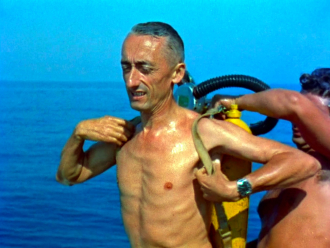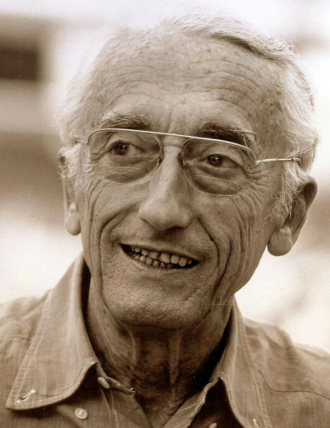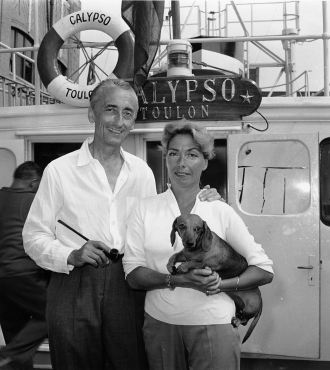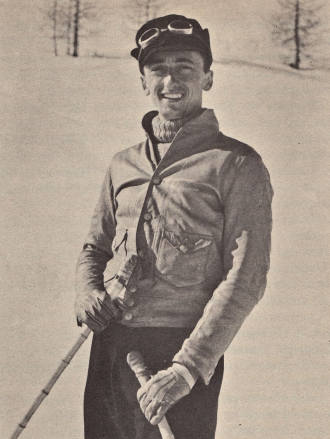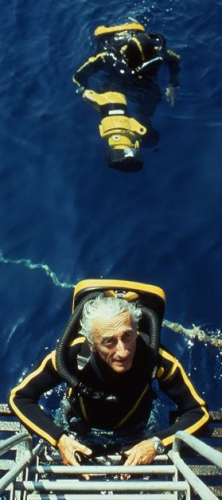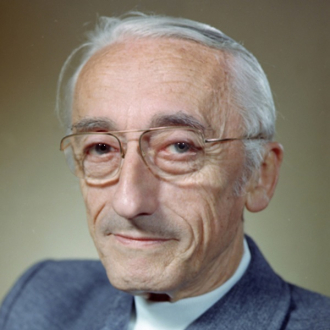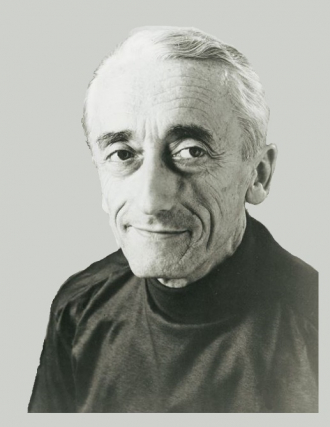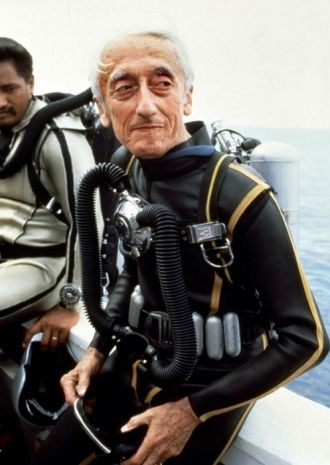Jacques Cousteau
Born Jacques-Yves Cousteau
11 June 1910
Saint-André-de-Cubzac, France
Died 25 June 1997 (aged 87)
Paris, France
Nationality French
Occupation Oceanographer
1950–1970s
In 1949, Cousteau left the French Navy.
In 1950, he founded the French Oceanographic Campaigns (FOC), and leased a ship called Calypso from Thomas Loel Guinness for a symbolic one franc a year. Cousteau refitted the Calypso as a mobile laboratory for field research and as his principal vessel for diving and filming. He also carried out underwater archaeological excavations in the Mediterranean, in particular at Grand-Congloué (1952).
With the publication of his first book in 1953, The Silent World, he correctly predicted the existence of the echolocation abilities of porpoises. He reported that his research vessel, the Élie Monier, was heading to the Straits of Gibraltar and noticed a group of porpoises following them. Cousteau changed course a few degrees off the optimal course to the center of the strait, and the porpoises followed for a few minutes, then diverged toward mid-channel again. It was evident that they knew where the optimal course lay, even if the humans did not. Cousteau concluded that the cetaceans had something like sonar, which was a relatively new feature on submarines.
In 1954, Cousteau conducted a survey of Abu Dhabi waters on behalf of British Petroleum. Among those accompanying him was Louis Malle who made a black-and-white film of the expedition for the company. Cousteau won the Palme d'Or at the Cannes Film Festival in 1956 for The Silent World co-produced with Malle. In 1957, Cousteau took over as leader of the Oceanographic Museum of Monaco. Afterward, with the assistance of Jean Mollard, he made a "diving saucer" SP-350, an experimental underwater vehicle which could reach a depth of 350 meters. The successful experiment was quickly repeated in 1965 with two vehicles which reached 500 meters. In 1957, he was elected as director of the Oceanographical Museum of Monaco. He directed Précontinent, about the experiments of diving in saturation (long-duration immersion, houses under the sea), and was admitted to the United States National Academy of Sciences.
He was involved in the creation of Confédération Mondiale des Activités Subaquatiques and served as its inaugural president from 1959 to 1973.
Cousteau also took part in inventing the "SP-350 Denise Diving Saucer" in 1959 which was an invention best for exploring the ocean floor, as it allowed one to explore on solid ground.
In October 1960, a large amount of radioactive waste was going to be discarded in the Mediterranean Sea by the Commissariat à l'énergie atomique (CEA). The CEA argued that the dumps were experimental in nature, and that French oceanographers such as Vsevelod Romanovsky had recommended it. Romanovsky and other French scientists, including Louis Fage and Jacques Cousteau, repudiated the claim, saying that Romanovsky had in mind a much smaller amount. The CEA claimed that there was little circulation (and hence little need for concern) at the dump site between Nice and Corsica, but French public opinion sided with the oceanographers rather than with the CEA atomic energy scientists. The CEA chief, Francis Perrin, decided to postpone the dump. Cousteau organized a publicity campaign which in less than two weeks gained wide popular support. The train carrying the waste was stopped by women and children sitting on the railway tracks, and it was sent back to its origin.
Cousteau on the Calypso.
In the 1960s Cousteau was involved with a set of three projects to build underwater "villages"; the projects were named Precontinent I, Precontinent II and Precontinent III. Each ensuing project was aimed at increasing the depth at which people continuously lived under water, and were an attempt at creating an environment in which men could live and work on the sea floor. The projects are best known as Conshelf I (1962), Conshelf II (1963), and Conshelf III (1965). The names "Precontinent", and "Continental Shelf Station" (Conshelf) were used interchangeably by Cousteau.
A meeting with American television companies (ABC, Métromédia, NBC) created the series The Undersea World of Jacques Cousteau, with the character of the commander in the red bonnet inherited from standard diving dress intended to give the films a "personalized adventure" style. This documentary television series ran for ten years from 1966 to 1976. A second documentary series, The Cousteau Odyssey, ran from 1977 to 1982 on public television stations.
In 1970, he wrote the book The Shark: Splendid Savage of the Sea with his son Philippe. In this book, Cousteau described the oceanic whitetip shark as "the most dangerous of all sharks."
In December 1972, two years after the volcano's last eruption, The Cousteau Society was filming Voyage au bout du monde on Deception Island, Antarctica, when Michel Laval, Calypso's second in command, was struck and killed by a rotor of the helicopter that was ferrying between Calypso and the island.
In 1973, along with his two sons and Frederick Hyman, he created the Cousteau Society for the Protection of Ocean Life, Frederick Hyman being its first President.
In 1975, John Denver released the tribute song "Calypso" on his album Windsong, and on the B-side of his hit song "I'm Sorry". "Calypso" became a hit on its own and was later considered the new A-side, reaching #2 on the charts.
In 1976, Cousteau located the wreck of HMHS Britannic. He also found the wreck of the French 17th-century ship-of-the-line La Therese in coastal waters of Crete.
In 1977, together with Peter Scott, he received the UN International Environment prize.
On 28 June 1979, while the Calypso was on an expedition to Portugal, his second son Philippe, his preferred and designated successor and with whom he had co-produced all his films since 1969, died in a PBY Catalina flying boat crash in the Tagus river near Lisbon. Cousteau was deeply affected. He called his then eldest son, the architect Jean-Michel, to his side. This collaboration lasted 14 years.
1980–1990s
From 1980 to 1981, he was a regular on the animal reality show Those Amazing Animals, along with Burgess Meredith, Priscilla Presley, and Jim Stafford.
Cousteau's Diving Saucer
In 1980, Cousteau traveled to Canada to make two films on the Saint Lawrence River and the Great Lakes, Cries from the Deep and St. Lawrence: Stairway to the Sea.
In 1985, he received the Presidential Medal of Freedom from Ronald Reagan.
On 24 November 1988, he was elected to the Académie française, chair 17, succeeding Jean Delay. His official reception under the cupola took place on 22 June 1989, the response to his speech of reception being given by Bertrand Poirot-Delpech. After his death, he was replaced by Érik Orsenna on 28 May 1998.
In June 1990, the composer Jean Michel Jarre paid homage to the commander by entitling his new album Waiting for Cousteau. He also composed the music for Cousteau's documentary "Palawan, the last refuge".
On 2 December 1990, his wife Simone Cousteau died of cancer.
In June 1991, in Paris, Jacques-Yves Cousteau remarried, to Francine Triplet, with whom he had (before this marriage) two children, Diane and Pierre-Yves. Francine Cousteau currently continues her husband's work as the head of the Cousteau Foundation and Cousteau Society. From that point, the relations between Jacques-Yves and his elder son worsened. In 1992, he was invited to Rio de Janeiro, Brazil, for the United Nations' International Conference on Environment and Development, and then he became a regular consultant for the UN and the World Bank.
On 11 January 1996, Calypso was accidentally rammed and sunk in the port of Singapore by a barge. The Calypso was refloated and towed home to France.
Jacques-Yves Cousteau died of a heart attack on 25 June 1997 in Paris, two weeks after his 87th birthday. He was buried in the family vault at Saint-André-de-Cubzac, his birthplace. An homage was paid to him by the town by naming the street which runs out to the house of his birth "rue du Commandant Cousteau", where a commemorative plaque was placed.
In his last years, after marrying again, Cousteau became involved in a legal battle with his son Jean-Michel over Jean-Michel licensing the Cousteau name for a South Pacific resort, resulting in Jean-Michel Cousteau being ordered by the court not to encourage confusion between his for-profit business and his father's non-profit endeavours.
In 2007, the International Watch Company introduced the IWC Aquatimer Chronograph "Cousteau Divers" Special Edition. The timepiece incorporated a sliver of wood from the interior of Cousteau's Calypso research vessel. Having developed the diver's watch, IWC offered support to The Cousteau Society. The proceeds from the timepieces' sales were partially donated to the non-profit organization involved in conservation of marine life and preservation of tropical coral reefs.
Religious views
"The Holy Scriptures and The Environment" in the posthumous work The Human, the Orchid, and the Octopus, he is quoted as stating that "The glory of nature provides evidence that God exists."

